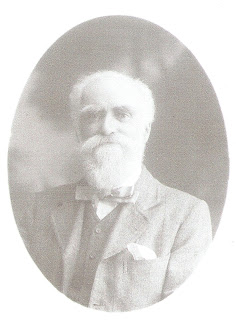


The English Wikipedia tells us that “In the Unua Adresaro, an early directory of supporters of Esperanto, Richard Geoghegan (pictured here) appears as number 264.” It goes on to call him, under a photo, “first Esperantist in the English-speaking world”. The Esperanto Vikipedio makes a more cautious claim, calling him “ŝajne la unua angle parolanta esperantisto”. (apparently the first English-speaking Esperantist).
The booklet called, in full, Adresaro de la personoj kiuj ellernis la Lingvon « Esperanto », serio 1, 1889 (illustrated here), does indeed list the first thousand learners, but it does not give them numbers, nor is there any indication that these names are listed in order of registration; indeed they are in alphabetical order. Giving his new address in Tacoma, Washington seven years later, Geoghegan gives himself the number 264 - see “Novaj Esperantistoj” Serio XVI, 1896 - but numbers were not published for the first thousand.
It is certainly true that there are very few British citizens who appear in a list overwhelming packed with citizens of the then Russian empire. By my calculations, 956 of the first thousand were Russians (including Poles, Ukrainians and residents of the Baltic countries)
So who are the other contenders for the crown of “The First British Esperantist”? One candidate is Pierce Essex O'Brien Butler (1858 – 1954), son of an Irish aristocratic family. He would certainly have considered himself British. He was educated in Germany, then served as interpreter with Her Britannic Majesty’s Consular Service in 1880 in China, acting as Pro-Consul between 1888 and 1893 in Tainan, Taiwan. His address in the first Adresaro is given as “H.B.M. Consular Service, China, Ĥ” (this letter signifying Ĥinujo, the word used for China in the language’s early years.
Another aristocratic candidate, this time from Northern Ireland, is James Douglas of Glenarm Castle, County Antrim.
A third contender is C.K. Fletcher of Birkenhead, the very same town on the Wirral where Geoghegan was brought up. In fact Richard Geoghegan is not the only person of that surname listed. Listed with him, and presumably recruited by him are his mother B.G. (Bessie Gertrude) Geoghegan of Birkenhead and James T. (Theodore) Geoghegan of Liverpool. Also from Liverpool are James A. Hinchliff and John Mercer of the International Patent Office there.
Finally there is another woman – far from a token woman, namely Helen Schultess-Young, from a legal and literary family in London.
It is not known which of those listed besides Geoghegan continued to use the new language, but it is not possible on the evidence currently available to say with confidence who the first Briton was to use Esperanto.
In the autumn of 1887, when the language Esperanto had just appeared, According to Richardson (Shamrocks on the Tanana, 2009) it was not Geoghegan himself but his friend Walter J. Crawhill, who read an article about the new international language and immediately wrote to Dr L.L. Zamenhof in Latin, but Geoghegan was able to use the German edition of his Unua Libro (First Book) which Zamenhof sent. Having learned the language from this book, a while later Geoghegan received from Zamenhof the first copies of the same book in an English translation by the Warsaw enthusiast, Geoghegan warned Zamenhof that this translation was a poor one, probably not by a native speaker, and it would bring Esperanto into disrepute in the English-speaking world. As a result, Zamenhof asked Geoghegan to produce a more suitable translation himself, which he did. The original faulty translation was withdrawn, and in 1889 Geoghegan's version was published, tasking the place of the earlier version.
Geoghegan can certainly lay claim to be the first propagandist of the new language
